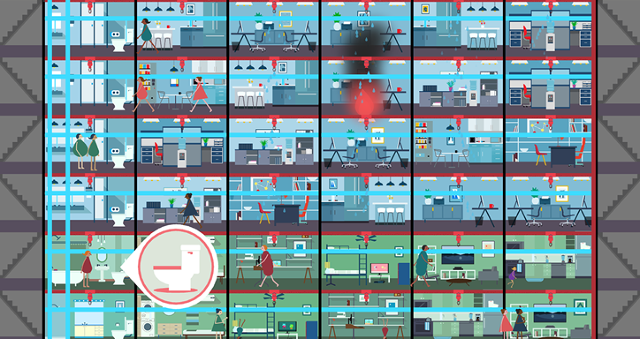Recently, a lucky photographer got a once-in-a-lifetime shot: A bolt of lightning striking the Empire State Building. I happened to be with my godson at the time it happened, so I showed him the picture. His first question: Where did the lightning go?

Usually, this question would have left me stymied. But this time, I'd been coincidentally playing Tinybop's latest app, Skyscrapers. So I was able to quickly pull my iPhone out of my pocket and show my godson what happens when lightning strikes a skyscraper like the Empire State Building: The electricity grounds itself, running conductively down the building to disperse itself through the earth.
"Cool," my godson said, then pulled my iPhone from my hand and started learning all about how skyscraper toilets work.
The seventh title in Tinybop's "Explorer's Library" series of apps, which aims to teach kids about subjects ranging from anatomy to geology through experimentation, not exposition, Skyscrapers puts kids in charge of their own city skyline. First, you create your skyscraper by dragging floors into the building. Green floors are residential, while blue floors are offices—a detail which seems without consequence at first, until the app starts teaching you how elevators work.
In the real world, elevator design can be surprisingly complicated, as buildings try to get employees moving between floors without creating elevator bank traffic jams. But Skyscrapers does a pretty good job explaining the basic theories of elevator design, with a cutaway view that shows how certain elevators only go to certain floors. By tapping on people waiting for the elevator, kids can see how certain shafts only go to the lower or top half of the building or residential floors or office floors, and how there are special elevators that go to every floor, even if it's not one that is open to the public.
As you grow your building to a certain height—750 meters is the biggest skyscraper you can make, a little shorter than Burj Khalifa—the skyscraper automatically takes on new architecture to help support it. For example, in Skyscrapers, once your tower goes over a certain number of floors, the top six stories or so will always have a section devoted to a gigantic tuned mass damper, a 700-plus-ton sphere that is brought in via helicopter to allow the building to maintain its balance in case of earthquake.

Speaking of earthquakes, in Skyscrapers, you can simulate one. A specific tab in the interface allows kids to afflict their skyscrapers with different environmental stresses, including earthquakes, hurricanes, and lightning strikes. When you trigger an in-app earthquake, you can see the springs-with-damper base isolators working underground to keep the building from shaking to pieces. When a lightning bolt hits the skyscraper, you can see the path the electricity takes as it goes to ground; and when a big blast of wind comes along, Skyscrapers will show you exactly how much the building can sway from the zephyr.
It's a kids' app, so of course there's a dose of scatology, too. The plumbing section of the app shows kids how all the toilets in a skyscraper are connected, thanks to in-app demonstrations of their plumbing system by a series of triangular and rectangular high-rise visitors flushing down yellow and brown orbs, along with the stray goldfish and piece of toilet paper. In Skyscrapers, you can also simulate water leaks, fires, and power surges, showing how the normal day-to-day activities of a skyscraper get disrupted by these sorts of events. You can even get a sense of scale in Skyscrapers by seeing how many large objects—such as a whale, a dinosaur, or a giraffe—can fit in a building. How many elephants tall can you build your skyscraper?
Illustrated by Mike Ellis, an artist who works for Herman Miller and the New Yorker, Skyscrapers might not give kids an engineering degree's worth of knowledge about how high-rises function. But like most of Tinybop's apps, Skyscrapers still demonstrates how much you can teach kids about how the grown-up world works—by showing, not telling. You can download it now on the iOS App Store for $2.99.